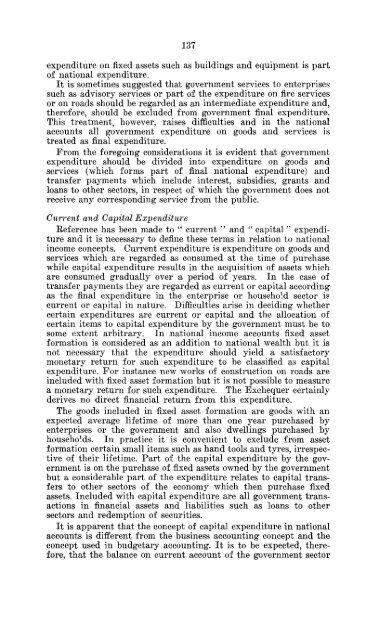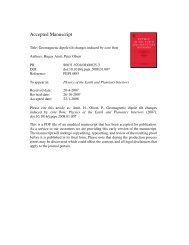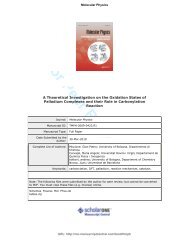An Analysis of Government Revenue and Expenditure in ... - TARA
An Analysis of Government Revenue and Expenditure in ... - TARA
An Analysis of Government Revenue and Expenditure in ... - TARA
You also want an ePaper? Increase the reach of your titles
YUMPU automatically turns print PDFs into web optimized ePapers that Google loves.
137<br />
expenditure on fixed assets such as build<strong>in</strong>gs <strong>and</strong> equipment is part<br />
<strong>of</strong> national expenditure.<br />
It is sometimes suggested that government services to enterprises<br />
such as advisory services or part <strong>of</strong> the expenditure on fire services<br />
or on roads should be regarded as an <strong>in</strong>termediate expenditure <strong>and</strong>,<br />
therefore, should be excluded from government f<strong>in</strong>al expenditure.<br />
This treatment, however, raises difficulties <strong>and</strong> <strong>in</strong> the national<br />
accounts all government expenditure on goods <strong>and</strong> services is<br />
treated as f<strong>in</strong>al expenditure.<br />
From the forego<strong>in</strong>g considerations it is evident that government<br />
expenditure should be divided <strong>in</strong>to expenditure on goods <strong>and</strong><br />
services (which forms part <strong>of</strong> f<strong>in</strong>al national expenditure) <strong>and</strong><br />
transfer payments which <strong>in</strong>clude <strong>in</strong>terest, subsidies, grants <strong>and</strong><br />
loans to other sectors, <strong>in</strong> respect <strong>of</strong> which the government does not<br />
receive any correspond<strong>in</strong>g service from the public.<br />
Current <strong>and</strong> Capital <strong>Expenditure</strong><br />
Eeference has been made to " current " <strong>and</strong> " capital " expenditure<br />
<strong>and</strong> it is necessary to def<strong>in</strong>e these terms <strong>in</strong> relation to national<br />
<strong>in</strong>come concepts. Current expenditure is expenditure on goods <strong>and</strong><br />
services which are regarded as consumed at the time <strong>of</strong> purchase<br />
while capital expenditure results <strong>in</strong> the acquisition <strong>of</strong> assets which<br />
are consumed gradually over a period <strong>of</strong> years. In the case <strong>of</strong><br />
transfer payments they are regarded as current or capital accord<strong>in</strong>g<br />
as the f<strong>in</strong>al expenditure <strong>in</strong> the enterprise or household sector i?<br />
current or capital <strong>in</strong> nature. Difficulties arise <strong>in</strong> decid<strong>in</strong>g whether<br />
certa<strong>in</strong> expenditures are current or capital <strong>and</strong> the allocation <strong>of</strong><br />
certa<strong>in</strong> items to capital expenditure by the government must be to<br />
some extent arbitrary. In national <strong>in</strong>come accounts fixed asset<br />
formation is considered as an addition to national wealth but it is<br />
not necessary that the expenditure should yield a satisfactory<br />
monetary return for such expenditure to be classified as capital<br />
expenditure. For <strong>in</strong>stance new works <strong>of</strong> construction on roads are<br />
<strong>in</strong>cluded with fixed asset formation but it is not possible to measure<br />
a monetary return for such expenditure. The Exchequer certa<strong>in</strong>ly<br />
derives no direct f<strong>in</strong>ancial return from this expenditure.<br />
The goods <strong>in</strong>cluded <strong>in</strong> fixed asset formation are goods with an<br />
expected average lifetime <strong>of</strong> more than one year purchased by<br />
enterprises or the government <strong>and</strong> also dwell<strong>in</strong>gs purchased by<br />
households. In practice it is convenient to exclude from asset<br />
formation certa<strong>in</strong> small items such as h<strong>and</strong> tools <strong>and</strong> tyres, irrespective<br />
<strong>of</strong> their lifetime. Part <strong>of</strong> the capital expenditure by the government<br />
is on the purchase <strong>of</strong> fixed assets owned by the government<br />
but a considerable part <strong>of</strong> the expenditure relates to capital transfers<br />
to other sectors <strong>of</strong> the economy which then purchase fixed<br />
assets. Included with capital expenditure are all government transactions<br />
<strong>in</strong> f<strong>in</strong>ancial assets <strong>and</strong> liabilities such as loans to other<br />
sectors <strong>and</strong> redemption <strong>of</strong> securities.<br />
It is apparent that the concept <strong>of</strong> capital expenditure <strong>in</strong> national<br />
accounts is different from the bus<strong>in</strong>ess account<strong>in</strong>g concept <strong>and</strong> the<br />
concept used <strong>in</strong> budgetary account<strong>in</strong>g. It is to be expected, therefore,<br />
that the balance on current account <strong>of</strong> the government sector
















